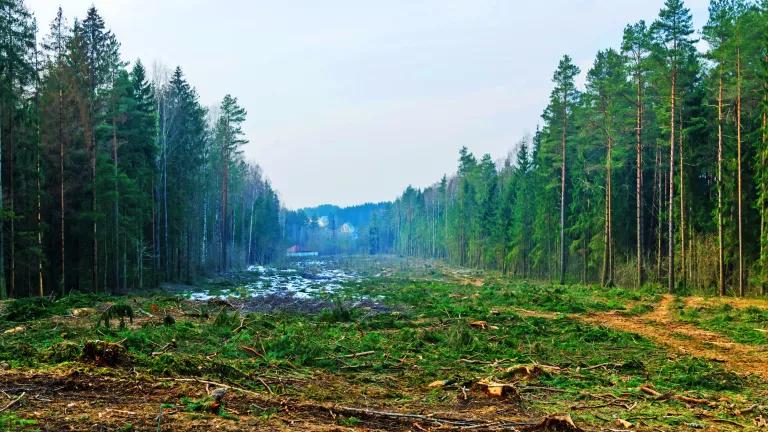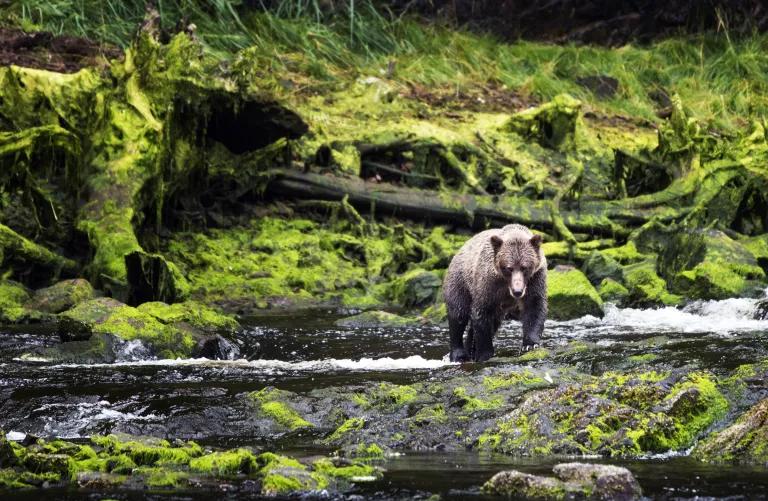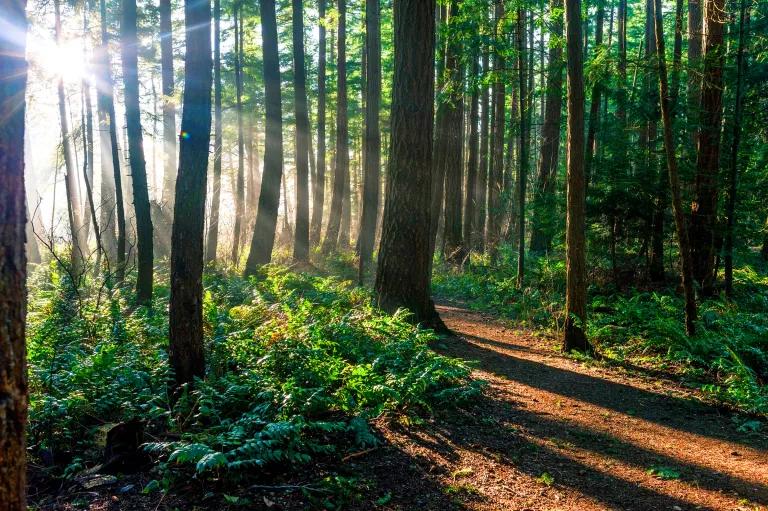Want to Fight Climate Change? Stop Clearcutting Our Carbon Sinks.
Forests are among our greatest allies in the global warming fight. Let’s protect them so they can protect us.

Clearcutting in Belarus
Vadzim Kandratsenkau/Alamy Stock Photo
Forests cover a third of all the land on earth. They provide habitat for 80 percent of terrestrial species and livelihoods for 1.6 billion people. On top of all that, they are powerhouses for carbon sequestration, absorbing as much as 30 percent of our carbon emissions. (Only the oceans can rival that.)
So forest health and conservation are key weapons in the worldwide fight against climate change. And we need to cut global carbon pollution to a level that our forests and other ecosystems can process naturally, says Anthony Swift, director of NRDC’s Canada Project.
“It makes no sense to clearcut one of the world’s most important tools for fighting climate change,” Swift says. But that’s exactly what’s happening. Globally, between 1990 and 2015, we lost the equivalent of 1,000 football fields’ worth of forest per hour, according to the World Bank. In addition to destroying some of the earth’s most precious ecosystems, deforestation and forest degradation are together the second-largest source of global carbon emissions (after the burning of fossil fuels)—at a time when the planet can least afford to exacerbate the problem.
You know the image: previously dense green forests carved, cleared, and turned into a pockmarked desert-brown wasteland with unnatural precision. Clearcutting is basically the chopping down of every marketable tree from a selected area. This is happening across the globe—from the rainforests of South America, Indonesia, and the Democratic Republic of Congo to the wooded wetlands of the American South, from the old-growth forests of the Pacific Northwest to the ring of boreal forest covering the majority of the globe’s northern latitudes. And one bill proposed at the U.S. federal level would go so far as to open up millions of new acres, as well as national monuments, to razing.
Below are some of the ways clearcut logging is degrading habitat and impairing climate efforts worldwide.
Destroys ecosystems
Logging companies practice clearcutting in many ways across the world. In some regions, foresters remove most, if not all, native trees and burn any remaining “debris” such as unwanted trees, shrubs, vines, and other plants. Then they bulldoze the ground and douse it with herbicides. In some areas, particularly in the tropics and developing countries, crops and cattle take over the scarred landscape. In more northern latitudes, clearcut spaces become tree plantations, where the timber industry raises only commercially desirable species. Such manufactured, simplified environments are neither hospitable to wildlife nor resilient to environmental threats such as climate change, blight, or natural disasters. And even when forests are left to regenerate naturally, “what regrows is seldom what was there before,” says Swift.
Slashes biodiversity

wanderluster/iStockPhoto
The complex web of life within a forest ecosystem comprises plants, animals, bacteria, and fungi, and many species can’t survive when that network of relationships breaks down. A clearcut’s footprint is vast, fragmenting and degrading entire swaths of forest, and logging roads slice things up even further. Native species are left to survive in smaller, isolated sections of less suitable environment while facing increased competition for dwindling resources. The result? Some species disappear altogether. Indeed, the world is in the midst of its sixth mass extinction, and this time, the human destruction of natural habitats is largely to blame. In the tropics alone, hundreds of thousands of plant and animal species could become vulnerable if we continue to encroach on untouched forest.
Erodes land
What happens when you destroy hundreds of miles of tree root systems and understory vegetation like grass, moss, and lichen? You damage the land’s ability to absorb water and retain its soil. This can exacerbate flooding when riparian buffer zones are compromised and can also cause landslides and soil erosion. Without rich topsoil, the ground is depleted of the nutrients that worms, fungi, and bacteria need to foster a healthy new forest.
Spoils water supplies
Clearcutting in watersheds can introduce new sediment, nutrients, and surface runoff (including chemicals used during the clearcutting and replanting process) to waterways. Logging roads can contribute additional runoff. Beyond wreaking havoc on aquatic wildlife, this type of nonpoint source pollution can also imperil valuable sources of drinking water.
Reverses carbon sinks
Clearcutting delivers a double whammy to the earth’s climate: Not only does it release huge amounts of carbon during the logging itself, but it can also undermine the future ability of habitats to soak up greenhouse gases from the atmosphere. In other words, a forest becomes far less effective at being a carbon sink, one of our best tools in the fight against climate change. (FYI: Dodgy carbon accounting methods used by countries with large forest industries and strong industry lobbies sometimes obscure this fact.)
Exacts a steep social toll on indigenous groups
Some 70 million indigenous people around the globe depend on healthy forests for not only their livelihoods but also their cultural identities. Clearcutting jeopardizes sources of food, water, income, and very ways of life. In the Canadian boreal forest, Youth Chief Melanie Neeposh of the Waswanipi Cree describes Quebec’s Broadback River Valley as “basically our last intact forest. All the traditional and cultural activities that we practice out there on the land, that’s who we are. That’s us.”
Deforestation vs. degradation
Deforestation—when a forest is converted into something totally different (think farmland, towns, roads, strip malls)—usually garners the biggest headlines. But there is another problem that no one talks about, forest degradation―when the quality of a rich, biologically complex ecosystem goes downhill―and it is this process that more accurately describes the impacts of logging. Once degraded, a forest may grow back, but it no longer works the same or provides the same benefits or ecosystem services that it did before being cut down.

The boreal forest, Canada
Pamela Powell/Alamy Stock Photo
A good example of this can be found in Canada’s boreal forest, home to many of the world’s largest intact, old-growth areas—and one of our greatest carbon stores. While the Canadian government touts its low deforestation rates and “sustainable” forestry management, it fails to account for forest degradation, too. Over the past 20 years, Canada has logged approximately 28 million acres of boreal forest (an area nearly the size of Ohio), with about 90 percent of those acres clearcut. That’s a lot of tree stumps, but because Canada requires regeneration after harvesting (on paper, at least) the country maintains its forests are fine. But there are clear signs, from satellite imagery to declining boreal caribou herd numbers, that they’re not. And considering the boreal’s trees and plants remove the emissions equivalent of 24 million passenger vehicles from the atmosphere annually, that’s bad news for us all.
What can you do?

A wall made with sustainable cedarwood
Roy Langstaff/Alamy Stock Photo
As global citizens and consumers, we have a say in whether our forests, from the Canadian wilds to the American South to the Amazon jungle, are cut and cleared. We can and should make every effort to consume fewer wood products (especially paper and other throwaway items), to recycle what we do consume, and to demand the sustainable sourcing of wood that is used in the products that we do choose to buy. The health of our forests and the future of our climate depend on it.
This NRDC.org story is available for online republication by news media outlets or nonprofits under these conditions: The writer(s) must be credited with a byline; you must note prominently that the story was originally published by NRDC.org and link to the original; the story cannot be edited (beyond simple things such as grammar); you can’t resell the story in any form or grant republishing rights to other outlets; you can’t republish our material wholesale or automatically—you need to select stories individually; you can’t republish the photos or graphics on our site without specific permission; you should drop us a note to let us know when you’ve used one of our stories.
Biomass 101
When Customers and Investors Demand Corporate Sustainability
What Are the Causes of Climate Change?
Biomass 101
When Customers and Investors Demand Corporate Sustainability
What Are the Causes of Climate Change?
Biomass 101
When Customers and Investors Demand Corporate Sustainability
What Are the Causes of Climate Change?
Biomass 101
When Customers and Investors Demand Corporate Sustainability